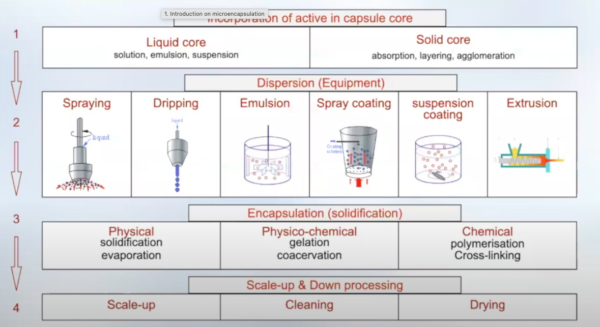Exploring Depths: Innovations in Additive Microencapsulation

Microencapsulation enhances the performance of additives in a variety of plastics applications.
This technology is invaluable for incorporating additives that possess explosive properties, are challenging to handle, exhibit high reactivity, or are PCMs. Additionally, it finds utility in applications requiring precise release control or self-healing properties.
You can also read: Top 5 Additives for Packaging Production
Inside Microencapsulation Theory
Microencapsulation involves coating tiny particles or droplets with a continuous film of polymeric material. The core of the microcapsule called the encapsulant, is surrounded by a coating known as the shell or wall. This shell acts as a microscopic barrier, isolating and protecting the encapsulated core from the external environment. It also controls the release of the encapsulant, preventing it from migrating out entirely or at a desired rate when necessary.
How are Additives Encapsulated?
The encapsulation process comprises several steps to encase small particles or droplets within a protective shell. Initially, the core material, whether solid, liquid, or gas, is selected based on desired properties. The first step typically involves preparing the core material through emulsification, suspension, or solvent evaporation techniques. Next, the team selects a coating material, often a polymer, based on its compatibility with the core material and the desired release properties. They then apply this coating material to the core using techniques such as coacervation, spray-drying, or fluidized bed coating. After encapsulation, manufacturers dry the microcapsules to remove residual solvents and ensure stability.

Microencapsulation process. Courtesy of Bioencapsulation & Microencapsulation.
Applications in the plastics industry
The plastics industry finds several applications for microencapsulation:
Phase Change Materials (PCMs) for Green Building
In Green Building, microencapsulation technology optimizes heating and cooling efficiency by PCM microcapsule implementation. PCM is a substance that releases or absorbs significant amounts of energy during phase transition. This characteristic makes it suitable to store and release energy.
QE2 Platinum pioneered a groundbreaking application of PCM microcapsules, showcasing their functionality. Researchers from the company developed a unique type of gypsum drywall capable of cyclically absorbing and releasing heat. The PCM salt mats, encased in FR-Plastic film and aluminum foil, are strategically installed in attics. They aid in effectively regulating temperature fluctuations and lowering cooling costs.
UV absorbers & stabilizers
The microencapsulation technique controls the release of active agents such as absorbents and UV stabilizers. Not only do these products improve the UV stability of plastics in outdoor applications, but they also reduce environmental impact. They achieve this by reducing the need for replacements and waste generation.
UV microcapsules find applications in the agricultural, automotive, recreational, and marine sectors.
Microencapsulated flame retardants
Red Phosphorus (RP) is used as a Flame Retardant (FR) and is added to plastics to reduce flammability. When the flame retardant is reactive, combustible, or explosive—without posing a risk of fire or explosion— RP becomes crucial.
One of the principal uses of microencapsulated red phosphorus (MRP) as FR is in masterbatches. It makes it easier to handle and avoids fire during mixing and processing.
Self-healing
Microencapsulated additives significantly improve material durability and longevity, especially in critical sectors like automotive and aerospace. Designed to release their contents upon detecting damage, they initiate self-healing processes that repair affected areas, preventing further deterioration. These mechanisms not only minimize maintenance but also extend component lifespan. It results in significant reductions in time and costs for repairs and replacements.
Overall, microencapsulation offers a versatile toolkit for improving the performance, safety, and longevity of plastic products across various industries. As research and development in this field continue, we can expect even more innovative applications and advancements in the future.
